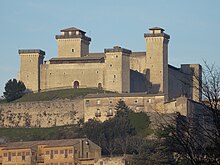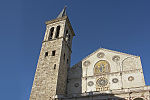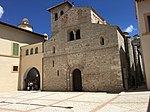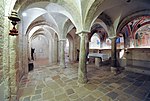Spoleto
| Spoleto | ||
|---|---|---|

|
|
|
| Country | Italy | |
| region | Umbria | |
| province | Perugia (PG) | |
| Coordinates | 42 ° 44 ' N , 12 ° 44' E | |
| height | 396 m slm | |
| surface | 349 km² | |
| Residents | 37,767 (Dec. 31, 2019) | |
| Population density | 108 inhabitants / km² | |
| Post Code | 06049 | |
| prefix | 0743 | |
| ISTAT number | 054051 | |
| Popular name | Spoletini | |
| Patron saint |
San Ponziano (January 14th) |
|
| Website | Spoleto | |
 Spoleto |
||
Spoleto is an Italian city in the Umbria region . The city has 37,767 inhabitants (as of December 31, 2019) and is located in the province of Perugia . The size of the urban area amounts to 349 km², making Spoleto one of the largest municipalities in Umbria in terms of area.
history
The oldest traces of a settlement from the Bronze Age were found on the dominant Sant'Elia hill in today's urban area. From the end of the 8th century BC And throughout the 7th century BC BC Spoleto was probably the most important center of power in southern Umbria. In the necropolis of Piazza d'Armi one discovered u. a. ornate king's sceptres , warriors' burials with tools, women with large decorative rings and several toddler graves containing religious, political and military status symbols. The burial of a 9–12 month old boy is unique. In addition to a dagger and lance, he was also given small bronze armor disks (cardiophylakes) to protect his body.
The first mention of the ancient Spoletium as the foundation of a Colonia comes from the year 241 BC. After the battle of Lake Trasimeno in 217 BC. BC Spoletium was attacked by Hannibal , who could be repulsed by the inhabitants. During the 2nd Punic War the city was an ally of Rome . However, during the Roman Civil Wars, she suffered from the troops of Gaius Marius and Sulla . Sulla confiscated the area in and around Spoletium 82 BC. After his victory over Crassus . Since then the city has been a garrison ( municipium ). In the 1st century Spoleto became a bishopric (today's Archdiocese of Spoleto-Norcia ).
In the Roman Empire , the city was a flourishing trading center, but historically of minor importance. The city itself was connected to the Via Flaminia via a feeder that departed from the main route in Narni and then reunited with it at the Forum Flaminii . Another ancient route led to Norcia . Martial mentions the wine from Spoleto. Aemilianus , who was proclaimed emperor by his soldiers in Moesia , was slain by them shortly before the beginning of a battle against his rival Valerian here in 253. Documents from Emperor Constantine the Great from 326 and Emperor Julian from 362 come from Spoleto. The founding of the episcopal seat in Spoleto dates back to the 4th century. The city was an important fortress during the Vandal Incursion and the Gothic Wars . The Gothic military leader Totila had the walls razed.
Under the Lombards , Spoleto became the capital of the independent Duchy of Spoleto (around 570). This extended over a large part of central Italy. Two members of the ducal dynasty of the Guidonen were crowned Italian kings and emperors at the end of the 9th century. The Margravine Matilda finally transferred the duchy along with other goods to Pope Gregory VII.
In 1155 the city was destroyed by Friedrich Barbarossa . In 1213 the final occupation was finally made by Pope Gregory IX. When the papal court moved to Avignon , however, the city was fought over in the turmoil of the wars between Ghibellines and Guelphs , until Cardinal Gil Alvarez De Albornoz in 1354 reincorporated the city into the Papal States. In 1499 Lucrezia Borgia was governor for a few months.
In 1809 the city became the préfecture (administrative seat) of the French Trasimène department . Giovanni Maria Mastai-Ferretti, who later became Pope Pius IX. became Archbishop of Spoleto in 1827 . In 1860, Spoleto came into the possession of Italian troops.
population
| 1871 | 1901 | 1921 | 1951 | 1971 | 1991 | 2001 | 2016 |
|---|---|---|---|---|---|---|---|
| 21,168 | 24,648 | 28,215 | 38,155 | 36,156 | 37,763 | 37,889 | 38.035 |
Attractions
The cathedral
At the end of a large, sloping staircase is the central square of the city with the cathedral . It is called Santa Maria Assunta and was built from 1175 after the troops of Barbarossa had destroyed the previous building, as a result of a renewed dispute between loyal to the emperor and loyal to the papacy (see article " Ghibellines and Guelphs "). The facade is not uniform, but the result of an extension. It has a total of eight rose windows that were used to illuminate the extended interior. The top three roses, the ogival niches and the mosaic (dated 1207) belong to the second construction phase. The central rose in the middle dates from the end of the 12th century and is described in literature as one of the most magnificent in Umbria. The whole area around the cathedral, together with the other buildings, has a great theatrical effect and is actually used for this purpose.
The interior of the cathedral was completely redesigned in 1638. The very colorful frescoes in the choir area are worth seeing , for example by Filippo Lippi the “Coronation of the Virgin” from 1469. Lippi, one of the main masters of the Florentine early Renaissance , is famous for a small, delicate story: he had his future wife as a young monk robbed from the monastery . This colorful fresco here in Spoleto is his last work.
Fresco of the apse of the cathedral
Sant'Eufemia
Spoleto has some very old churches. Sant'Eufemia from the second half of the 12th century is one of the most important Romanesque buildings in Umbria, which is why it was restored for a very long time, from 1907 to 1954. However, it is believed that during this period not only was restored, but that the church was only closed for a long time because the restorers were waiting for the necessary funds.
The interior of the church is very peculiar. There is an open gallery almost the same size as the first floor. A northern influence from Lombardy is clearly noticeable here. Lombard art is characterized by rich and often restless decorations, whose canon of forms often uses motifs from oriental areas. And that can also be read from the most interesting column in the room, the third column from the right, which was either taken over from a previous building or from another early Romanesque building and used again. This column is an architectural fragment from the late 8th or early 9th century, decorated on three sides.
Basilica di San Salvatore
In the 4th / 5th The church of San Salvatore, built in the 17th century, is the cella of a Roman temple and is considered to be one of the most important testimonies to early Christian art . In the 8th century it was rebuilt by the Lombards . Since June 2011, the basilica has been part of a group of building ensembles that was included in the UNESCO World Heritage list under the title The Lombards in Italy, Places of Power (568 to 774 AD) .
The Rocca and Ponte delle Torri
This papal castle was built from 1359 by Gattapone, the builder from Gubbio . Below this castle complex is probably the most famous building in the city, the "Bridge of the Towers" ( Ponte delle Torri ). It is not a Roman aqueduct, but a medieval one from the 13th and 14th centuries, a rare revival of the ancient aqueduct shape. In addition to their rarity, they are so famous for their enormous dimensions of 230 meters in length and 76 meters in height.
San Pietro Fuori le mura
A little outside the city is the church of S. Pietro fuori le mura (San Pietro extra moenia) from the end of the 12th century. The facade has relief zones around the portal, which are among the most important examples of Romanesque sculpture around 1200. The division of the facade into rectangular fields is typical for Umbria (Keller, p. 411 ff.). In front of the empty ground there are figural reliefs as if in a parallel layer. This flat conception of relief and ground, the simple, clear field framing in rectangles, make this facade a forerunner of the marble forehead of the Orvietan cathedral, which is around 120 years younger.
As always with church facades, the individual scenes naturally have a symbolic meaning that we are no longer necessarily familiar with today. For example, a lion attacks a soldier. In the Tuscan and Umbrian animal symbolism, the lion is compared to God. Here the lion is ruthless towards anyone who, like this soldier, is attached to worldly things.
San Ponziano, crypt with spolia
San Ponziano
Also outside the city center is San Ponziano, the church of the city patron from the late 12th century. (It is not easy to get to by car and is therefore rarely visited. You drive out of town on the expressway and then turn right onto a small path.) Then you stand in front of a simple facade.
The crypt, which is illuminated with warm light, is particularly worth seeing . All of its five naves have their own apses , some of which are still frescoed. Numerous spolia , i.e. columns that are used again, can be found here, which have sometimes been inserted upside down.
Culture
Festival dei Due Mondi
The “Festival of Two Worlds” was introduced in 1958 by the composer Gian Carlo Menotti (1911–2007) and runs from June to July. Performances in the fields of opera , theater , ballet , chamber and symphonic music take place in several locations in the city . The performances in front of the cathedral's facade are particularly popular. The rows of spectators are pulled up the entire staircase in the evening. To improve the acoustics, the orchestra is spanned by a tent structure that can be raised quickly.
When this festival of the two worlds takes place, certain streets are cordoned off in the evening and the respective performance spaces are prepared. Admission to the performances is then regulated via sales stands.
Wine
Named Spoleto DOC are white wines and sparkling wines , mainly from the grape variety Trebbiano offered. The wines have had a "controlled designation of origin " (Denominazione di origine controllata - DOC ) since 2011 , which was last updated on March 7, 2014.
The types of wine are:
- a blend of Spoleto Bianco , which must contain at least 50% Trebbiano. A maximum of 50% other white grape varieties approved for cultivation in the Umbria region may be added
- and the almost varietal wines: Spoleto Trebbiano Spoletino , Spoleto Trebbiano Spoletino Superiore , Spoleto Trebbiano Spoletino Spumante and the Spoleto Trebbiano Spoletino Passito . These wines must consist of at least 85% Trebbiano. A maximum of 15% other white grape varieties approved for cultivation in the Umbria region may be added.
Town twinning
-
 Schwetzingen in Baden-Württemberg ( Germany )
Schwetzingen in Baden-Württemberg ( Germany ) -
 Orange (Vaucluse) in Provence ( France )
Orange (Vaucluse) in Provence ( France ) -
 Charleston (South Carolina) in the USA
Charleston (South Carolina) in the USA
sons and daughters of the town
- Girolamo Fantini (1600–1675), trumpeter and composer
- Basilio Pompili (1858–1931), Curia Cardinal of the Roman Catholic Church
- Ugo Tucci (1917–2013), historian
- Enrico Sabbatini (1932–1998), costume designer and production designer
- Luciano Biondini (* 1971), jazz accordionist
- Ivan Zaytsev (* 1988), volleyball player
Other personalities
- Simon von Collazzone († 1250), a Franciscan venerated blessed, companion of St. Francis; died here and is buried in the cathedral
literature
- Laura Manca, Joachim Weidig (eds.): Spoleto 2700 years ago. Scepter and royal children from the necropolis of Piazza d'Armi. Spoleto 2700 anni fa. Sepolture principesche dalla necropoli di Piazza d'Armi. Spoleto 2014.
- Carlo Bertelli : The mosaics - from antiquity to the present (1988). Augsburg 1996, p. 224
- Liana Di Marco: Spoleto. Arte e storia . Narni - Terni 1980
- Carola Jäggi : San Salvatore in Spoleto. Studies of late antique and early medieval architecture in Italy . 1998
- Harald Keller : The Art Landscapes of Italy (1960). Frankfurt am Main 1983
- Klaus Zimmermanns: Umbria . Cologne 1987. (DuMont Art Travel Guide), p. 267, Figs. 70–73, 76, color plate 19
Web links
- Official website (Italian)
- umbriatourism.it: Spoleto , pictures and interesting facts (German)
- Official website of public and private tourism professionals (Italian)
Individual evidence
- ↑ Statistiche demografiche ISTAT. Monthly population statistics of the Istituto Nazionale di Statistica , as of December 31 of 2019.
- ↑ Angelika Franz: Mysterious grave goods: The drinking boots of the little princes. In: Spiegel Online . January 5, 2015, accessed January 2, 2017 .
- ↑ ISTAT
- ↑ a b Disciplinare di Produzione della Denominazione di Origine Controllata (production regulations and description). (PDF) In: ismeamercati.it. November 27, 2017, accessed July 16, 2018 (Italian).




















